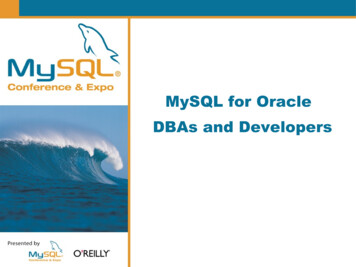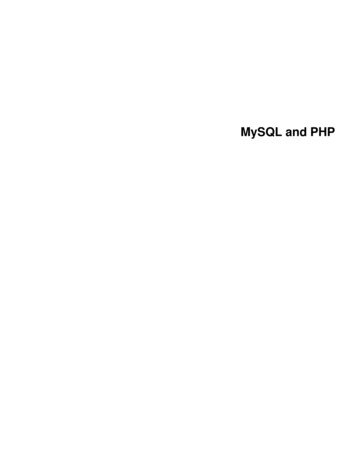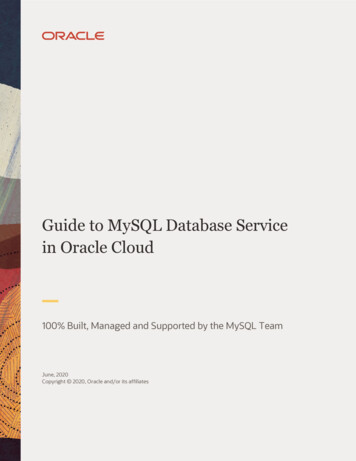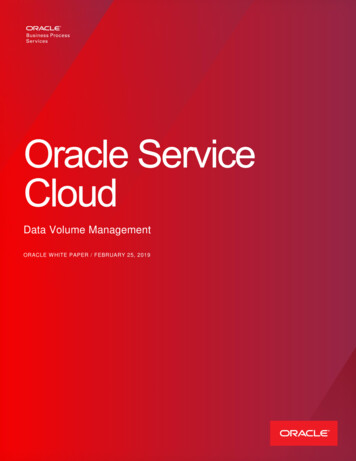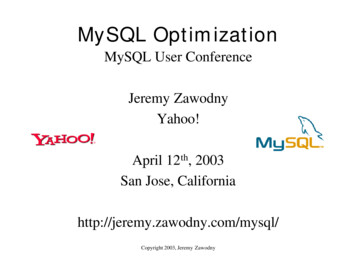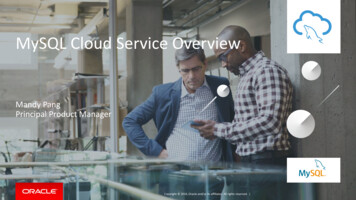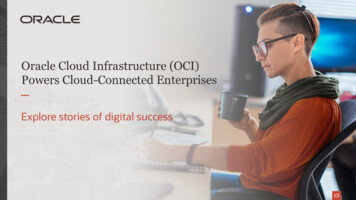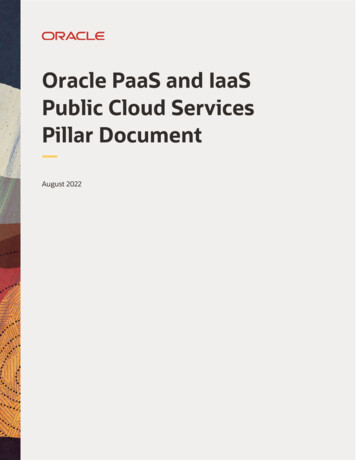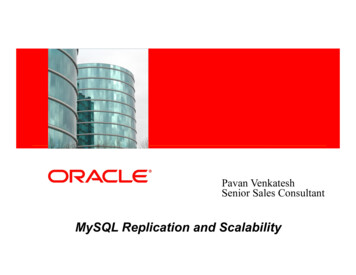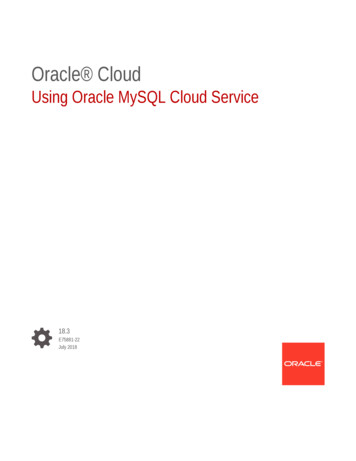
Transcription
Oracle CloudUsing Oracle MySQL Cloud Service18.3E75881-22July 2018
Oracle Cloud Using Oracle MySQL Cloud Service, 18.3E75881-22Copyright 2016, 2018, Oracle and/or its affiliates. All rights reserved.This software and related documentation are provided under a license agreement containing restrictions onuse and disclosure and are protected by intellectual property laws. Except as expressly permitted in yourlicense agreement or allowed by law, you may not use, copy, reproduce, translate, broadcast, modify,license, transmit, distribute, exhibit, perform, publish, or display any part, in any form, or by any means.Reverse engineering, disassembly, or decompilation of this software, unless required by law forinteroperability, is prohibited.The information contained herein is subject to change without notice and is not warranted to be error-free. Ifyou find any errors, please report them to us in writing.If this is software or related documentation that is delivered to the U.S. Government or anyone licensing it onbehalf of the U.S. Government, then the following notice is applicable:U.S. GOVERNMENT END USERS: Oracle programs, including any operating system, integrated software,any programs installed on the hardware, and/or documentation, delivered to U.S. Government end users are"commercial computer software" pursuant to the applicable Federal Acquisition Regulation and agencyspecific supplemental regulations. As such, use, duplication, disclosure, modification, and adaptation of theprograms, including any operating system, integrated software, any programs installed on the hardware,and/or documentation, shall be subject to license terms and license restrictions applicable to the programs.No other rights are granted to the U.S. Government.This software or hardware is developed for general use in a variety of information management applications.It is not developed or intended for use in any inherently dangerous applications, including applications thatmay create a risk of personal injury. If you use this software or hardware in dangerous applications, then youshall be responsible to take all appropriate fail-safe, backup, redundancy, and other measures to ensure itssafe use. Oracle Corporation and its affiliates disclaim any liability for any damages caused by use of thissoftware or hardware in dangerous applications.Oracle and Java are registered trademarks of Oracle and/or its affiliates. Other names may be trademarks oftheir respective owners.Intel and Intel Xeon are trademarks or registered trademarks of Intel Corporation. All SPARC trademarks areused under license and are trademarks or registered trademarks of SPARC International, Inc. AMD, Opteron,the AMD logo, and the AMD Opteron logo are trademarks or registered trademarks of Advanced MicroDevices. UNIX is a registered trademark of The Open Group.This software or hardware and documentation may provide access to or information about content, products,and services from third parties. Oracle Corporation and its affiliates are not responsible for and expresslydisclaim all warranties of any kind with respect to third-party content, products, and services unless otherwiseset forth in an applicable agreement between you and Oracle. Oracle Corporation and its affiliates will not beresponsible for any loss, costs, or damages incurred due to your access to or use of third-party content,products, or services, except as set forth in an applicable agreement between you and Oracle.
ContentsPreface12AudienceviiDocumentation AccessibilityviiRelated DocumentsviiConventionsviiGetting Started with MySQL Cloud ServiceAbout Oracle MySQL Cloud Service1-1About MySQL Cloud Service Deployments1-2Computing Power1-2Database Storage1-3Automatic Backup Configuration1-3Before You Begin with MySQL Cloud Service1-4How to Begin with MySQL Cloud Service Subscriptions1-5About MySQL Cloud Service Roles and Users1-5Accessing MySQL Cloud Service Console1-6Typical Workflow for Using MySQL Cloud Service1-6About MySQL Cloud Service Deployments in Oracle Cloud Infrastructure1-7Managing the MySQL Cloud Service Life CycleCreating a MySQL Server DeploymentCreating a QuickStart Database DeploymentEnterprise Edition2-12-102-11Creating a Cloned Instance from a Snapshot2-11Viewing All MySQL Server Deployments2-12Viewing Detailed Information for a MySQL Server Deployment2-13Viewing Activities for MySQL Server Deployments in an Identity Domain2-13Stopping, Starting and Restarting2-13Rebooting a Compute Node2-17Deleting a MySQL Server Deployment2-17Tracking the Number of MySQL Server Deployments in an Account2-18iii
Creating and Managing IP Reservations3Creating an IP Reservation2-18Deleting an IP Reservation2-19Creating and Managing Snapshots2-19Managing Tags2-21Creating, Assigning, and Unassigning Tags2-21Finding Tags and Instances Using Search Expressions2-22Managing Network Access to MySQL Cloud ServiceAbout Network Access to MySQL Cloud Service3-1Generating a Secure Shell (SSH) Public/Private Key Pair3-2Generating an SSH Key Pair on UNIX and UNIX-Like Platforms Using the sshkeygen Utility3-3Generating an SSH Key Pair on Windows Using the PuTTYgen Program3-3Creating an SSH Tunnel to a Compute Node Port53-5Creating an SSH Tunnel Using the PuTTY Program on Windows3-53-7Administering MySQL Cloud ServiceAdding Storage to MySQL Cloud Service4-1Scaling MySQL Cloud Service4-2Updating or Adding a New SSH Public Key4-3Maintaining the Manageability of Your Database Deployments4-3Loading Data into the MySQL Database4-4Tuning Database Performance on MySQL Cloud Service4-4Accessing MySQL Cloud ServiceConnecting to a Compute Node Through Secure Shell (SSH)63-4Creating an SSH Tunnel Using the ssh Utility on LinuxEnabling Access to a Compute Node Port42-185-1Connecting to a Compute Node Using the ssh Utility on UNIX and UNIX-LikePlatforms5-1Connecting to a Compute Node Using the PuTTY Program on Windows5-2Backing Up and Restoring Databases on MySQL Cloud ServiceAbout Backing Up Databases on MySQL Cloud Service6-1Creating an On-Demand Backup6-3Creating an On-Demand Backup by Using the MySQL Cloud Service ConsoleDeleting a Backup6-36-4iv
Customizing the Current Backup Configuration6-4Restoring from a Specific Backup6-5Restoring from a Specific Backup by Using the MySQL Cloud Service ConsoleRestoring to a Specific Point in TimeRestoring to a Specific Point in Time by Using the MySQL Cloud ServiceConsoleUpdating the Password for Backing Up to the Storage Cloud76-67-1Checking Prerequisites Before Applying a Patch7-2Applying a Patch Using the MySQL Cloud Service ConsoleRolling Back a PatchRolling Back a Patch by Using the MySQL Cloud Service Console7-27-37-37-47-4Migrating MySQL Databases to MySQL Cloud ServiceMigrating MySQL DataB6-6About Patching an Oracle MySQL Cloud Service InstanceApplying a PatchA6-5Patching MySQL Cloud ServiceChecking Patch Prerequisites86-58-1Characteristics of a Newly Created DeploymentLinux User AccountsA-1Locations of Installed SoftwareA-2Oracle Cloud Pages for Administering MySQL Cloud ServiceMySQL Cloud Service Instances PageB-1MySQL Cloud Service Activity PageB-3MySQL Cloud Service SSH Access PageB-4MySQL Cloud Service IP Reservations PageB-5MySQL Cloud Service Overview PageB-6MySQL Cloud Service Access Rules PageB-8MySQL Cloud Service Backup PageB-9MySQL Cloud Service Patching PageB-10MySQL Cloud Service Snapshots PageB-11Create MySQL Cloud Service: Service PageB-11Create MySQL Cloud Service: Service Details PageB-12Create MySQL Cloud Service: Supported TimezonesB-16v
Create MySQL Cloud Service: Confirmation PageB-19vi
PrefaceThis document describes how to manage and monitor Oracle MySQL CloudServiceand provides references to related documentation.Topics Audience Documentation Accessibility Related Documents ConventionsAudienceThis document is intended for Oracle Cloud users who want to manage and monitorOracle MySQL Cloud Service.Documentation AccessibilityFor information about Oracle's commitment to accessibility, visit the OracleAccessibility Program website at http://www.oracle.com/pls/topic/lookup?ctx acc&id docacc.Access to Oracle SupportOracle customers that have purchased support have access to electronic supportthrough My Oracle Support. For information, visit http://www.oracle.com/pls/topic/lookup?ctx acc&id info or visit http://www.oracle.com/pls/topic/lookup?ctx acc&id trsif you are hearing impaired.Related DocumentsFor more information, see these Oracle resources: Getting Started with Oracle Cloud Using Oracle Compute Cloud Service (for PaaS)ConventionsThe following text conventions are used in this document:vii
PrefaceConvention MeaningboldfaceBoldface type indicates graphical user interface elements associated with anaction, or terms defined in text or the glossary.italicItalic type indicates book titles, emphasis, or placeholder variables for which yousupply particular values.monospaceMonospace type indicates commands within a paragraph, URLs, code inexamples, text that appears on the screen, or text that you enter.viii
1Getting Started with MySQL Cloud ServiceThis section describes how to get started withOracle MySQL Cloud Service foradministrators and developers.Topics About Oracle MySQL Cloud Service About MySQL Cloud Service Deployments Before You Begin with MySQL Cloud Service How to Begin with MySQL Cloud Service Subscriptions About MySQL Cloud Service Roles and Users Accessing MySQL Cloud Service Console Typical Workflow for Using MySQL Cloud Service About MySQL Deployments on OCIAbout Oracle MySQL Cloud ServiceOracle MySQL Cloud Service provides you the ability to deploy MySQL Server in theCloud, with each deployment containing a single MySQL Server. You have full accessto the features and operations available with MySQL Server, with Oracle providing thecomputing power, physical storage and tooling to simplify maintenance andmanagement operations.When you create a deployment, MySQL Cloud Service creates compute nodes to hostthe MySQL Server, using computing and storage resources provided by OracleCompute Cloud Service. Additionally, it provides access to the compute nodes (andthus to MySQL Server) using networking resources provided by Oracle ComputeCloud Service.When you create a deployment, MySQL Server and supporting software is installed foryou, a MySQL database is created and configured using values you provide whencreating the deployment, and the MySQL Server is started. Additionally, you can directMySQL Cloud Service to set up automatic backups. Finally, the deployment includescloud tooling that simplifies backup, recovery, and patching operations. You have rootprivilege, so you can load and run software in the compute environment. You have fulladministrative privileges for the MySQL Server. You are responsible for making anychanges to the automated maintenance setup, and you are responsible for recoveryoperations in the event of a failure.MySQL Enterprise Monitor is also delivered as part of the service. This monitoring toolcan be installed when the service is created, using the Create Service wizard, or fromthe command line on the compute node.1-1
Chapter 1About MySQL Cloud Service DeploymentsNote:If you intend to install MySQL Enterprise Monitor, it is strongly recommendedthat you dedicate a single MySQL Cloud Service instance to this installation.It is also recommended that this MySQL Server deployed on that instance isnot used for any other purpose than the MySQL Enterprise Monitor’srepository. A compute node shape of OC5 is the recommended minimum.MySQL Server Feature AvailabilityAll MySQL Enterprise Edition Server features are available in Oracle MySQL CloudService.Note:If MySQL Transparent Data Encryption (TDE) is enabled on the MySQLinstance, it is not currently possible to restore a backup of that instance.About MySQL Cloud Service DeploymentsWhen you create MySQL Server deployments on MySQL Cloud Service, you use theCreate MySQL Cloud Service Instance wizard, which steps you through the process ofmaking the choices that create a deployment tailored to your needs. These choicesinclude: Computing Power Database Storage Automatic Backup ConfigurationComputing PowerWhen creating a database deployment on MySQL Cloud Service, you choose thecomputing power for the associated compute node from a list of supported OCPU(Oracle CPU) and processor RAM combinations. The combinations you can choosefrom depend on the infrastructure you are creating the deployment in: In Oracle Cloud Infrastructure:–VM.Standard1.1 - 1.0 OCPU, 7.0 GB RAM–VM.Standard1.2 - 2.0 OCPU, 14.0 GB RAM–VM.Standard1.4 - 4.0 OCPU, 30.0 GB RAM–VM.Standard1.8 - 8.0 OCPU, 56.0 GB RAM–VM.Standard1.16 - 16.0 OCPU, 240.0 GB RAM–VM.Standard2.1 - 1.0 OCPU, 15.0 GB RAM–VM.Standard2.2 - 2.0 OCPU, 30.0 GB RAM–VM.Standard2.4 - 4.0 OCPU, 60.0 GB RAM–VM.Standard2.8 - 8.0 OCPU, 120.0 GB RAM1-2
Chapter 1About MySQL Cloud Service Deployments –BM.Standard1.32 - 36.0 OCPU, 256.0 GB RAM–BM.Standard2.52 - 52.0 OCPU, 768.0 GB RAMIn Oracle Cloud Infrastructure Classic:––General Purpose:*OC3 - 1 OCPU, 7.5 GB RAM*OC4 - 2 OCPU, 15 GB RAM*OC5 - 4 OCPU, 30 GB RAM*OC6 - 8 OCPU, 60 GB RAM*OC7 - 16 OCPU, 120 GB RAMHigh Memory:*OC1M - 1 OCPU, 15 GB RAM*OC2M - 2 OCPU, 30 GB RAM*OC3M - 4 OCPU, 60 GB RAM*OC4M - 8 OCPU, 120 GB RAM*OC5M - 16 OCPU, 240 GB RAMDatabase StorageWhen creating a database deployment on MySQL Cloud Service, you choose theamount of usable data storage you want for your database in gigabyte (GB)increments up to a maximum of 1 TB (1024 GB).Automatic Backup ConfigurationWhen creating a new database deployment on MySQL Cloud Service, you choosewhether you want automatic backups to be configured for the database. Your choicesare: Both Cloud Storage and Local Storage—30 days' worth of backups are kept,with the 7 most recent days' worth available directly on the compute node’s localstorage. This can be changed later. None—automatic backups are not configured.Note:Do not use the Oracle Storage Cloud container that you are using to back upMySQL Cloud Service databases to cloud storage for any other purpose. Forexample, do not also use it to back up Oracle Java Cloud Service instancesto cloud storage. Using the container for multiple purposes can result inbilling errors.1-3
Chapter 1Before You Begin with MySQL Cloud ServiceBefore You Begin with MySQL Cloud ServiceBefore you begin using MySQL Cloud Service, you should be familiar with thefollowing technologies: Oracle CloudSee Getting Started with Oracle Cloud for information about Oracle Cloud. Oracle Compute Cloud ServiceMySQL Cloud Service compute nodes use a variety of Oracle Compute CloudService resources. See Using Oracle Compute Cloud Service for informationabout instances and the disk images, compute shapes, storage volumes, IPreservations, security lists, security rules, and secure shell (SSH) public keys thatare associated with them. Oracle Storage Cloud Service containersMySQL Cloud Service uses MySQL Enterprise Backup to back up to cloud storagewhich, in turn, uses Oracle Cloud Infrastructure Object Storage Classic containersas repositories for backups to the cloud. Before you can create a container, youmust have access to Oracle Cloud Infrastructure Object Storage Classic. SeeAbout Oracle Storage Cloud Service in Using Oracle Cloud Infrastructure ObjectStorage ClassicNote:You must enable a Replication Policy on your Oracle Storage CloudService before attempting to use it with MySQL Cloud Service. For moreinformation, see Selecting a Replication Policy for Your Service Instance.Before you create a MySQL Cloud Service instance: Procure a MySQL Cloud Service subscription. Without an active subscription, youcannot create a MySQL Cloud Service instance. Create a Secure Shell (SSH) public/private key pair. The SSH keys are used tofacilitate secure access to the compute nodes that support your databasedeployments. See Generating a Secure Shell (SSH) Public/Private Key Pair. It isalso possible to create the key pair during the provisioning tasks. (Optional) Create a container in Oracle Storage Cloud Service to store backups oncloud storage. See Creating Containers in Using Oracle Storage Cloud Service. Itis also possible to create a storage container during provisioning. For moreinformation, see Creating a MySQL Server Deployment.Note:Do not use an Oracle Storage Cloud container that you use to back upMySQL Cloud Service databases for any other purpose. For example, donot also use it to back up Oracle Java Cloud Service instances. Usingthe container for multiple purposes can result in billing errors.1-4
Chapter 1How to Begin with MySQL Cloud Service SubscriptionsHow to Begin with MySQL Cloud Service SubscriptionsHere’s how to get started with MySQL Cloud Service trials and paid subscriptions:1.Request a trial environment or purchase a subscription to Oracle Cloud Services.See Subscribing to an Oracle Cloud Service Trial, Buying a Metered Subscriptionto an Oracle Cloud Service, or Buying a Nonmetered Subscription to an OracleCloud Service in Getting Started with Oracle Cloud.2.Set up your Oracle Cloud Services account. See Setting Up a Metered OracleCloud Services Account or Buying a Nonmetered Subscription to an Oracle CloudService in Getting Started with Oracle Cloud.3.Verify MySQL Cloud Service is ready to use. See Verifying That Metered OracleCloud Services Are Running or Verifying That a Service Is Running in GettingStarted with Oracle Cloud.4.Learn about MySQL Cloud Service users and roles. See About MySQL CloudService Roles and Users.5.Create accounts for your users and assign them appropriate privileges and roles.See Managing User Accounts and Managing User Roles in Managing andMonitoring Oracle Cloud.6.Be sure to review the prerequisites described in Before You Begin with MySQLCloud Service before you create your first MySQL Cloud Service .Note that an Oracle Public Cloud Services trial environment or purchased subscriptioncomes with Oracle IaaS Public Cloud Services, which provides you access to: Oracle Compute Cloud Service, which MySQL Cloud Service relies on Oracle Storage Cloud Service, which MySQL Cloud Service relies on for backupstorage.Despite the fact that these services are part of the Oracle IaaS Public Cloud Servicessubscription, use of their features by MySQL Cloud Service are billed to the OraclePublic Cloud Services subscription.About MySQL Cloud Service Roles and UsersIn addition to the roles and privileges described in Oracle Cloud User Roles andPrivileges in Getting Started with Oracle Cloud, the following role is created for MySQLCloud Service: MySQLCS MySQLAdministrators.When the MySQL Cloud Service account is first set up, the service administrator isgiven this role. User accounts with this role must be added before anyone else canaccess and use MySQL Cloud Service.The identity domain administrator can create more MySQL Cloud Serviceadministrators by creating user accounts and assigning the role to user. Forinformation about how to add user accounts in Oracle Cloud, see Managing UserAccounts and Managing and Monitoring Oracle Cloud.The following table summarizes the privileges given to a Tenant User in MySQLCloud Service:1-5
Chapter 1Accessing MySQL Cloud Service ConsoleDescription of PrivilegeMore InformationCan create and delete MySQL ServerdeploymentsCreating a MySQL Server DeploymentCan scale, patch, and back up or restoreMySQL Server deploymentsScaling MySQL Cloud ServiceDeleting a MySQL Server DeploymentPatching MySQL Cloud ServiceBacking Up and Restoring Databases onMySQL Cloud ServiceCan monitor and manage service usage inOracle CloudManaging and Monitoring Oracle CloudServices in Managing and Monitoring OracleCloudAccessing MySQL Cloud Service ConsoleTo access the MySQL Cloud Service console:1.Sign in to your Cloud Account and go to the My Services Dashboard.See Signing in to Your Cloud Account in Getting Started with Oracle Cloud.2.Click thenavigation menu in the top corner of the My Services Dashboard andthen click MySQL.The MySQL Cloud Service console opens.3.If a Welcome page is displayed, go to the Instances page by clicking Instances.For information about the details provided on the MySQL Cloud Service console, seeMySQL Cloud Service Instances Page.Typical Workflow for Using MySQL Cloud ServiceTo start using MySQL Cloud Service, refer to the following tasks as a guide:TaskDescriptionMore InformationSign up for a free creditpromotion or purchase asubscriptionProvide your information, and sign upHow to Begin with MySQL Cloud Servicefor a free trial or purchase a subscription Subscriptionsto Oracle MySQL Cloud Service(Does not apply to OracleCloud Machine)Add and manage usersand rolesCreate accounts for your users andassign them appropriate privileges.Assign the necessary MySQL CloudService roles.Managing User Accounts and ManagingUser Roles in Managing and MonitoringOracle Cloud, and About MySQL CloudService Roles and UsersCreate an SSH key pairCreate SSH public/private key pairs tofacilitate secure access to the computenodes associated with your databasedeployments.Generating a Secure Shell (SSH) Public/Private Key PairCreate a MySQL ServerdeploymentUse a wizard to create a new MySQLServer deployment.Creating a MySQL Server Deployment1-6
Chapter 1About MySQL Cloud Service Deployments in Oracle Cloud InfrastructureTaskDescriptionMore InformationEnable network accessPermit access to network servicesassociated with your MySQL Serverdeployments.About Network Access to MySQL CloudServiceLoad data into thedatabaseUse standard MySQL Server tools toload data into your databases.Loading Data into the MySQL DatabaseMonitor databasedeploymentsCheck on the health and performance of MySQL Enterprise Monitor 4.0 Manualindividual MySQL Server deployments.Monitor the serviceCheck on the day-to-day operation ofyour service, monitor performance, andreview important notifications.Managing and Monitoring Oracle CloudServices in Managing and MonitoringOracle CloudPatch a databasedeploymentApply a patch or roll back a patch.Patching MySQL Cloud ServiceBack up a databasedeploymentBack up a database or restore adatabase from a backup.Backing Up and Restoring Databases onMySQL Cloud ServiceAbout MySQL Cloud Service Deployments in Oracle CloudInfrastructureYou can create Oracle MySQL Cloud Service database deployments in Oracle CloudInfrastructure and in Oracle Cloud Infrastructure Classic.The environment that your database deployment provides in either type ofinfrastructure is substantially the same. A few differences exist in the underlyinginfrastructure components and in the supported capabilities. Awareness of thesedifferences will help you choose an appropriate infrastructure when creating adatabase deployment. Prerequisite steps before creating your first database deployment: In OracleCloud Infrastructure, you must perform the steps described in Prerequisites forOracle Platform Services on Oracle Cloud Infrastructure in the Oracle CloudInfrastructure documentation. In Oracle Cloud Infrastructure Classic, you must setthe replication policy in Oracle Cloud Infrastructure Object Storage Classic beforeyou create database deployments with backups to cloud storage, as described inSelecting a Replication Policy for Your Service Instance in Using Oracle CloudInfrastructure Object Storage Classic. Regions and availability domains: While creating a database deployment, youselect a region in Oracle Cloud Infrastructure Classic or Oracle CloudInfrastructure. If you select a region in Oracle Cloud Infrastructure, then you alsoselect an Availability Domain. A region in Oracle Cloud Infrastructure has multipleisolated availability domains, each with separate power and cooling. Theavailability domains within a region are interconnected using a low-latencynetwork. Subnets and IP networks: In Oracle Cloud Infrastructure Classic, you canoptionally attach a database deployment to an IP network that you definebeforehand. In Oracle Cloud Infrastructure, you must attach each databasedeployment to a subnet, which is a part of a virtual cloud network that you createin Oracle Cloud Infrastructure.1-7
Chapter 1About MySQL Cloud Service Deployments in Oracle Cloud Infrastructure Compute shapes: The range of compute shapes that you can select from whencreating a database deployment is different for Oracle Cloud Infrastructure andOracle Cloud Infrastructure Classic. For more information, see Computing Power. Backups to cloud storage: In Oracle Cloud Infrastructure, an Oracle CloudInfrastructure Object Storage bucket is used to store backups to cloud storage.You must create a storage bucket before you create database deploymentsconfigured to back up to cloud storage. In Oracle Cloud Infrastructure Classic, anOracle Cloud Infrastructure Object Storage Classic container is used to storebackups to cloud storage. You can create a storage container before you createdatabase deployments configured to back up to cloud storage, or you can have astorage container created at the same time as a database deployment. IP reservations: Currently, Oracle Cloud Infrastructure does not support IPreservations. Network access to database deployments: Regardless of the infrastructure thatyou create your database deployment in, the rules to provide network access tothe deployment are preconfigured for you. The interfaces that you use to managethese rules depend on the infrastructure that the deployment is created in:–For deployments in Oracle Cloud Infrastructure, you configure the rules, calledsecurity rules, in the Oracle Cloud Infrastructure interfaces.–For deployments in Oracle Cloud Infrastructure Classic, you configure therules, called access rules, in the Oracle MySQL Cloud Service interfaces. Notethat these access rules prohibit access by default (with the exception of SSHaccess on port 22), and you must enable them to provide access to otherports. Scaling database deployments: In Oracle Cloud Infrastructure, you cannot scalethe shape of a database deployment’s compute nodes; you can scale only thestorage. The minimum size of a new storage volume in Oracle Cloud Infrastructureis 50 GB. Snapshots and deployments cloned from snapshots: Currently, Oracle CloudInfrastructure does not support creating storage snapshots of single-instancedatabase deployments and then creating cloned deployments from the snapshots.1-8
2Managing the MySQL Cloud Service LifeCycleThis section describes tasks to manage the life cycle of MySQL Cloud Service.Topics Creating a MySQL Server Deployment Creating a Quickstart MySQL Cloud Service Deployment Creating a Cloned Instance from a Snapshot Viewing All MySQL Server Deployments Viewing Detailed Information for a MySQL Server Deployment Viewing Activities for MySQL Server Deployments in an Identity Domain Stopping, Starting and Restarting Rebooting a Compute Node Deleting a MySQL Server Deployment Tracking the Number of MySQL Server Deployments in an Account Creating and Managing IP Reservations Creating and Managing SnapshotsCreating a MySQL Server DeploymentTo create a database deployment on MySQL Cloud Service, use the Create MySQLCloud Service wizard as described in the following procedure.Before You BeginBefore you create a MySQL Server deployment on MySQL Cloud Service, ensure youhave created the following: An SSH public/private key pairWhen creating a MySQL Server deployment, you must associate an SSH publickey with the compute infrastructure supporting the deployment. You can upload afile containing the public key value or you can paste in the value of a public key.An SSH public key is used for authentication when you use an SSH client toconnect to a compute node associated with the deployment. When you connect,you must provide the private key that matches the public key.You generate an SSH public/private key pair using a standard SSH key generationtool. For more information, see Generating a Secure Shell (SSH) Public/PrivateKey Pair.2-1
Chapter 2Creating a MySQL Server DeploymentNote:It is also possible to create an SSH key pair in the Create MySQL CloudService Instance wizard. A cloud storage backup location (Optional)If you want to automatically back up your database to cloud storage, you mustassociate it with a cloud storage backup location. The type of location you specifydepends on the infrastructure the deployment is built on:–Oracle Cloud Infrastructure: cloud backups are stored in an Oracle CloudInfrastructure Object Storage bucket. You must create a storage bucket beforeyou create database deployments configured to back up to cloud storage.–Oracle Cloud Infrastructure Classic: cloud backups are stored in an OracleCloud Infrastructure Object Storage Classic container. You can create thecontainer beforehand and provide the wizard with information about it, or youcan have the wizard create the container for you.Note:The Cloud Storage Container field of the Create New Instancewizard on Oracle Cloud Infrastructure Classic is now populated witha default, valid URL, and a default container name, MySQLCS. Thiscontainer is created the first time you create a new instance. To usea different container name, edit the url to remove the defaultcontainer name, and replace with the desired name.The container becomes associated with MySQL Cloud Service. Onceassociated with MySQL Cloud Service, the container becomes part of yoursubscription (or trial) rather than part of an Oracle IaaS Public Cloud Servicessubscription (or trial).Whether you create the container beforehand or have the wizard do it for you,you are prompted for the following information about the container:*The name of the container*The user name and password of a user who has read/write access to thecontainerNote:Do not use the Oracle Cloud Infrastructure Object Storage Classiccontainer that you are using to back up MySQL Cloud Servicedatabases for any other purpose. For example, do not also use it toback up Oracle Java Clo
9. Click the Browse button next to the Private key file for authentication box. Then, in the Select private key file window, navigate to and open the private key file that matches the public key that is associated with the deployment . 10. In the Category tree, click Session. The Session panel is displayed. 11.

